unit 5Do you have a soccer ball Section A Grammar Focus-3c课件(共20张PPT)人教版七年级上册
文档属性
| 名称 | unit 5Do you have a soccer ball Section A Grammar Focus-3c课件(共20张PPT)人教版七年级上册 | 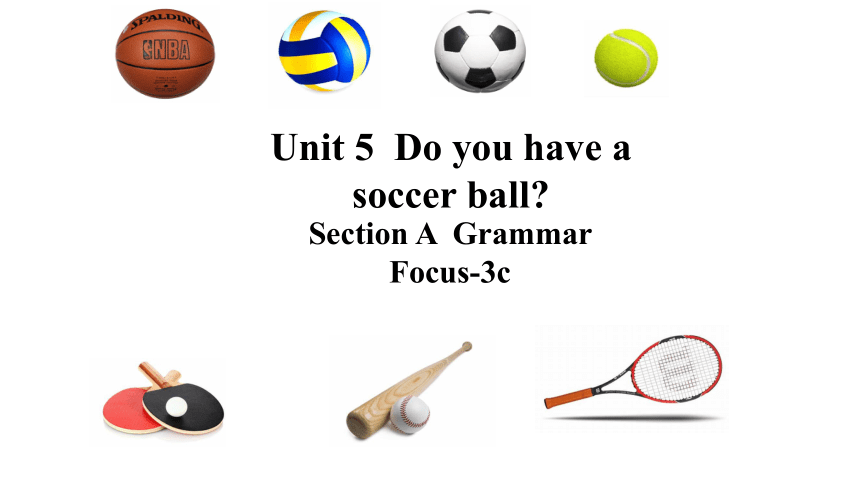 | |
| 格式 | pptx | ||
| 文件大小 | 1.7MB | ||
| 资源类型 | 教案 | ||
| 版本资源 | 人教新目标(Go for it)版 | ||
| 科目 | 英语 | ||
| 更新时间 | 2023-11-20 21:41:45 | ||
图片预览

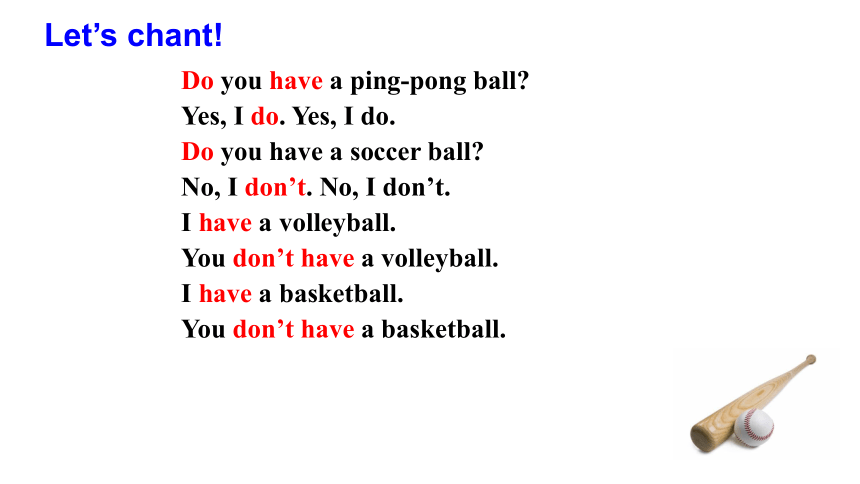

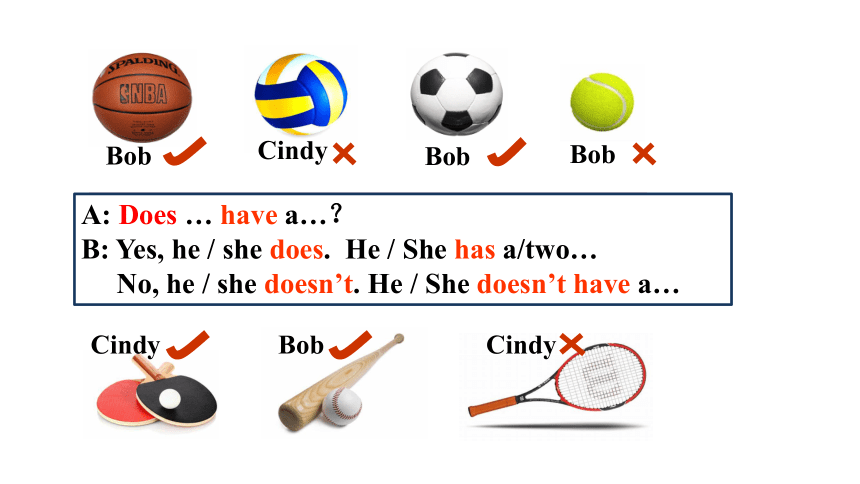


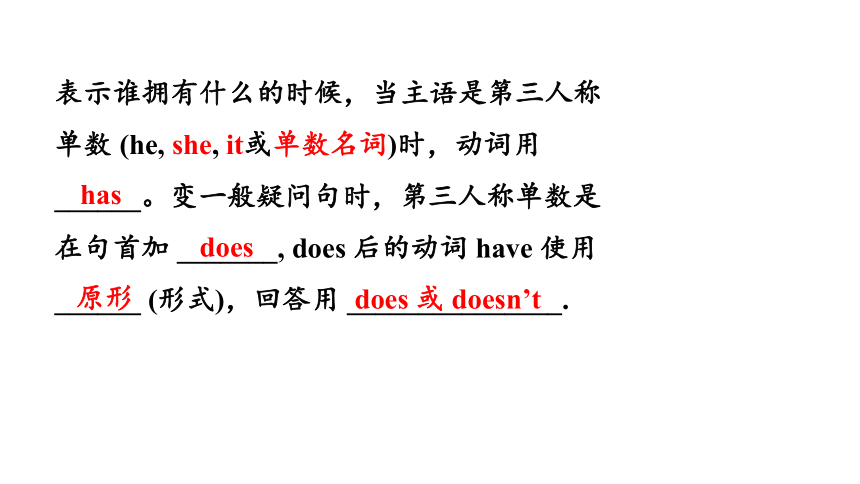
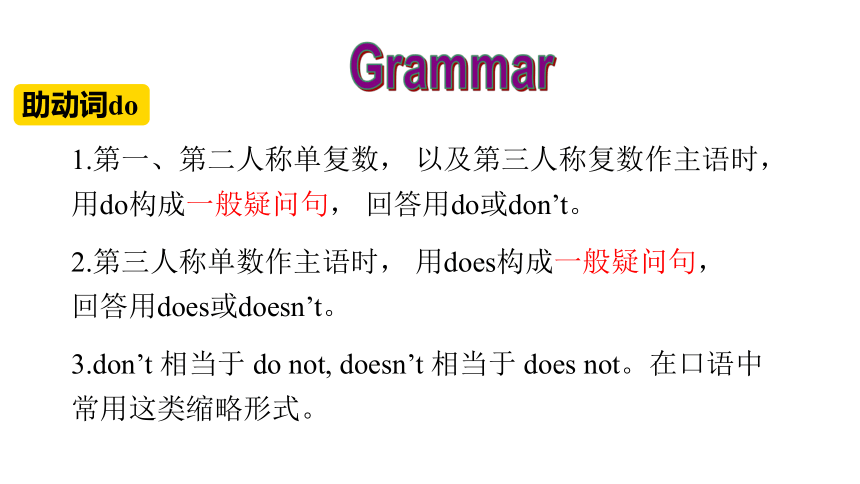
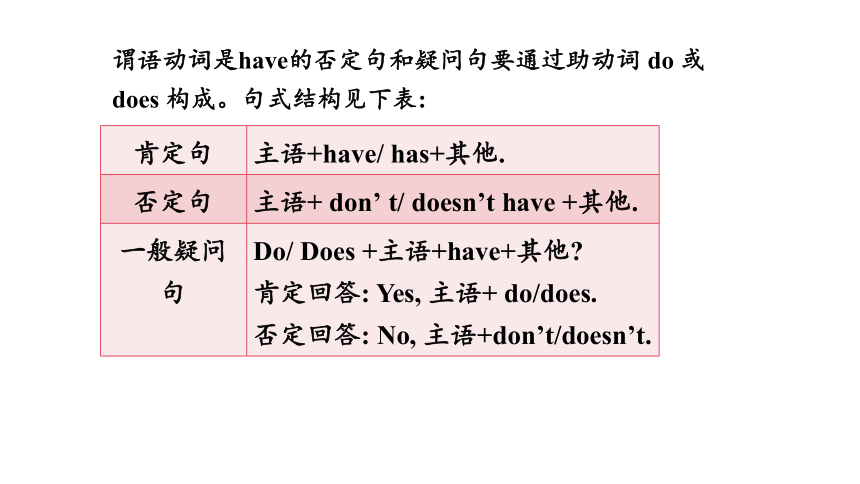
文档简介
(共20张PPT)
Section A Grammar
Focus-3c
Unit 5 Do you have a soccer ball
Let’s chant!
Do you have a ping-pong ball
Yes, I do. Yes, I do.
Do you have a soccer ball
No, I don’t. No, I don’t.
I have a volleyball.
You don’t have a volleyball.
I have a basketball.
You don’t have a basketball.
Balls
basketball
volleyball
soccer ball
ping-pong ball
tennis ball
tennis racket
ping-pong bat
baseball
baseball bat
Cindy
A: Do you have a…?
B: Yes, I do. I have a/two …
No, I don’t. I don’t have a…
A: Does … have a…?
B: Yes, he / she does. He / She has a/two…
No, he / she doesn’t. He / She doesn’t have a…
Bob
Bob
Bob
Bob
Cindy
Cindy
Grammar Focus
Do you have a baseball Yes, I do. / No, I don’t. I have a volleyball.
Do you have a ping-pong bat Yes, I do. / No, I don’t. I have a ping-pong ball.
Does she have a tennis ball Yes, she does. / No, she doesn’t.
She has a baseball.
Does he have a soccer ball Yes, he does. / No, he doesn’t.
He has two ping-pong bats.
Do they have a basketball Yes, they do. / No, they don’t.
They have a volleyball.
don’t=do not doesn’t=does not
表示谁拥有什么的时候,当主语是第一称 (I, we),第二人称 (you) 和第三人称复数 (they或其他复数名词等) 时,动词用 _____,变一般疑问句时,第一,二人称和第三人称复数是在句首加 _____, do后的动词 have 使用 ______ (形式),回答用 _____________.
have
do
原形
do 或 don’t
表示谁拥有什么的时候,当主语是第三人称单数 (he, she, it或单数名词)时,动词用 ______。变一般疑问句时,第三人称单数是在句首加 _______, does 后的动词 have 使用 ______ (形式),回答用 _______________.
has
does
原形
does 或 doesn’t
Grammar
助动词do
1.第一、第二人称单复数, 以及第三人称复数作主语时, 用do构成一般疑问句, 回答用do或don’t。
2.第三人称单数作主语时, 用does构成一般疑问句, 回答用does或doesn’t。
3.don’t 相当于 do not, doesn’t 相当于 does not。在口语中常用这类缩略形式。
谓语动词是have的否定句和疑问句要通过助动词 do 或 does 构成。句式结构见下表:
肯定句 主语+have/ has+其他.
否定句 主语+ don’ t/ doesn’t have +其他.
一般疑问句 Do/ Does +主语+have+其他
肯定回答: Yes, 主语+ do/does.
否定回答: No, 主语+don’t/doesn’t.
I / you / we / they
he / she / it / Eric
Do
Does
+
+
+
want ...
like ...
have ...
We use do or does to make a question.
助动词
主语
动词原形
遇第三人称变一般疑问句要在句首加_______
动词has要____________________.
Does
变为have
一加Does,二变have,三问号,改小写
Does
Does
Does
Does
John
Tina
He
She
have
have
have
have
s
s
s
s
a tennis ball .
a basketball .
a soccer ball .
two basketballs .
h
s
用 have/has 填空。
1. A dog _____ four legs. A bird ____ two legs.
2. Our school _____ a library.
3. We ____ 37 chairs in our classroom.
4. My sister ____ a nice toy car.
5. — Do Tom and his brother _____ a big bedroom
— Yes, they do.
has
has
has
have
has
have
Write each word in the correct place in the chart.
3a
I he they you we she it Eric
do does
I they
you we
he she
it Eric
3b
Fill in the blanks with do or does. Then practice the conversations with your partner.
A: you have a baseball
B: Yes, I .
A: Great! I have a bat. Let’s play!
Do
do
A: John have a soccer ball
B: No, he .
A: he have a ping-pong bat
B: Yes, he . I think he has a
ping-pong ball, too.
A: Hmm… let’s ask.
Does
doesn’t
Does
does
3c
Remember the things in Bob’s room. Then close your books and ask and answer questions with a partner.
A: Does Bob have a soccer ball
B: Yes, he does.
Make conversations with your partner. Talk about the pictures below.
A: Let’s play soccer.
B: I don’t have a soccer ball.
A: Well, let’s play volleyball.
B: That sounds good.
Make a survey. Write down the things you have and ask your partner what things she/ he has.
Things you have Things you don’t have Things she/ he has Things she/ he doesn’t have
Exercises
一、根据句意及汉语提示完成句子。
1. Do you have a ________(棒球)?
2. Nick ______(有)a new ping-pong bat.
3. We _______(有)a volleyball.
4. That _______(听起来)great.
5. Let’s _______ ___________(打篮球)with Mike.
baseball
has
have
sounds
play basketball
1. — _____ you have a volleyball
— No, I _____. But my sister _____ a new one.
A. Do, don’t, have B. Do, don’t, has
C. Does, doesn’t, have D. Does, doesn’t, has
2. — _____ Anna _____ a ping-pong bat — Yes, she _____.
A. Do, have, do B. Does, have, does
C. Do, have, has D. Does, have, has
二、单项选择。
B
B
Section A Grammar
Focus-3c
Unit 5 Do you have a soccer ball
Let’s chant!
Do you have a ping-pong ball
Yes, I do. Yes, I do.
Do you have a soccer ball
No, I don’t. No, I don’t.
I have a volleyball.
You don’t have a volleyball.
I have a basketball.
You don’t have a basketball.
Balls
basketball
volleyball
soccer ball
ping-pong ball
tennis ball
tennis racket
ping-pong bat
baseball
baseball bat
Cindy
A: Do you have a…?
B: Yes, I do. I have a/two …
No, I don’t. I don’t have a…
A: Does … have a…?
B: Yes, he / she does. He / She has a/two…
No, he / she doesn’t. He / She doesn’t have a…
Bob
Bob
Bob
Bob
Cindy
Cindy
Grammar Focus
Do you have a baseball Yes, I do. / No, I don’t. I have a volleyball.
Do you have a ping-pong bat Yes, I do. / No, I don’t. I have a ping-pong ball.
Does she have a tennis ball Yes, she does. / No, she doesn’t.
She has a baseball.
Does he have a soccer ball Yes, he does. / No, he doesn’t.
He has two ping-pong bats.
Do they have a basketball Yes, they do. / No, they don’t.
They have a volleyball.
don’t=do not doesn’t=does not
表示谁拥有什么的时候,当主语是第一称 (I, we),第二人称 (you) 和第三人称复数 (they或其他复数名词等) 时,动词用 _____,变一般疑问句时,第一,二人称和第三人称复数是在句首加 _____, do后的动词 have 使用 ______ (形式),回答用 _____________.
have
do
原形
do 或 don’t
表示谁拥有什么的时候,当主语是第三人称单数 (he, she, it或单数名词)时,动词用 ______。变一般疑问句时,第三人称单数是在句首加 _______, does 后的动词 have 使用 ______ (形式),回答用 _______________.
has
does
原形
does 或 doesn’t
Grammar
助动词do
1.第一、第二人称单复数, 以及第三人称复数作主语时, 用do构成一般疑问句, 回答用do或don’t。
2.第三人称单数作主语时, 用does构成一般疑问句, 回答用does或doesn’t。
3.don’t 相当于 do not, doesn’t 相当于 does not。在口语中常用这类缩略形式。
谓语动词是have的否定句和疑问句要通过助动词 do 或 does 构成。句式结构见下表:
肯定句 主语+have/ has+其他.
否定句 主语+ don’ t/ doesn’t have +其他.
一般疑问句 Do/ Does +主语+have+其他
肯定回答: Yes, 主语+ do/does.
否定回答: No, 主语+don’t/doesn’t.
I / you / we / they
he / she / it / Eric
Do
Does
+
+
+
want ...
like ...
have ...
We use do or does to make a question.
助动词
主语
动词原形
遇第三人称变一般疑问句要在句首加_______
动词has要____________________.
Does
变为have
一加Does,二变have,三问号,改小写
Does
Does
Does
Does
John
Tina
He
She
have
have
have
have
s
s
s
s
a tennis ball .
a basketball .
a soccer ball .
two basketballs .
h
s
用 have/has 填空。
1. A dog _____ four legs. A bird ____ two legs.
2. Our school _____ a library.
3. We ____ 37 chairs in our classroom.
4. My sister ____ a nice toy car.
5. — Do Tom and his brother _____ a big bedroom
— Yes, they do.
has
has
has
have
has
have
Write each word in the correct place in the chart.
3a
I he they you we she it Eric
do does
I they
you we
he she
it Eric
3b
Fill in the blanks with do or does. Then practice the conversations with your partner.
A: you have a baseball
B: Yes, I .
A: Great! I have a bat. Let’s play!
Do
do
A: John have a soccer ball
B: No, he .
A: he have a ping-pong bat
B: Yes, he . I think he has a
ping-pong ball, too.
A: Hmm… let’s ask.
Does
doesn’t
Does
does
3c
Remember the things in Bob’s room. Then close your books and ask and answer questions with a partner.
A: Does Bob have a soccer ball
B: Yes, he does.
Make conversations with your partner. Talk about the pictures below.
A: Let’s play soccer.
B: I don’t have a soccer ball.
A: Well, let’s play volleyball.
B: That sounds good.
Make a survey. Write down the things you have and ask your partner what things she/ he has.
Things you have Things you don’t have Things she/ he has Things she/ he doesn’t have
Exercises
一、根据句意及汉语提示完成句子。
1. Do you have a ________(棒球)?
2. Nick ______(有)a new ping-pong bat.
3. We _______(有)a volleyball.
4. That _______(听起来)great.
5. Let’s _______ ___________(打篮球)with Mike.
baseball
has
have
sounds
play basketball
1. — _____ you have a volleyball
— No, I _____. But my sister _____ a new one.
A. Do, don’t, have B. Do, don’t, has
C. Does, doesn’t, have D. Does, doesn’t, has
2. — _____ Anna _____ a ping-pong bat — Yes, she _____.
A. Do, have, do B. Does, have, does
C. Do, have, has D. Does, have, has
二、单项选择。
B
B
同课章节目录
- starters 预备篇(2012秋审查)
- Unit 1 Good morning !
- Unit 2 What’s this in English?
- Unit 3 What color is it ?
- Unit 1 My name's Gina.
- Section A
- Section B
- Unit 2 This is my sister.
- Section A
- Section B
- Unit 3 Is this your pencil?
- Section A
- Section B
- Unit 4 Where's my schoolbag?
- Section A
- Section B
- Unit 5 Do you have a soccer ball?
- Section A
- Section B
- Unit 6 Do you like bananas?
- Section A
- Section B
- Unit 7 How much are these socks?
- Section A
- Section B
- Unit 8 When is your birthday?
- Section A
- Section B
- Unit 9 My favorite subject is science.
- Section A
- Section B
